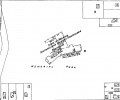Southwestern Michigan Tuberculosis Sanatorium
| Southwestern Michigan Tuberculosis Sanatorium | |
|---|---|
 | |
| Opened | 1954 |
| Closed | 1990 |
| Demolished | 2011 |
| Current Status | Demolished |
| Building Style | Single Building |
| Location | Kalamazoo, MI |
| Alternate Names |
|
History[edit]
In 1954 the Southwestern Michigan Tuberculosis Sanatorium was constructed at a cost of $2.5 million dollars. A four-story, 45,000 square foot building set on several rolling acres, it held 200 beds for tuberculosis patients who were housed in a modern facility on Kalamazoo's Northwest side. The surroundings, overlooking the city, were pleasant, and treatment methods for the disease were the most up-to-date and successful for the day.
The Kalamazoo State Hospital had housed its own tubercular patients in a special facility at the Oakland Drive campus. In December of 1965, all mental patients from around the state who had tuberculosis were transferred to the sanatorium in Kalamazoo. This included the patients from KPH. The transfers also enabled the mental hospital to eliminate a waiting list for adults who needed admission to the facility.
In 1966 the sanatorium housed 40 patients under treatment for TB only, 29 with TB transferred from mental hospitals all over Michigan, and 108 custodial cases transferred from the KRPH who were all elderly and required no psychiatric treatment. These last had been confined to the state hospital for many years. They no longer needed treatment, but were not able to return to the community and needed bed rest and care.
By 1969, treatment of tuberculosis had improved so dramatically and had been so successful that the State of Michigan ordered the sanatorium shut down as a treatment center for the disease. Since so many patients from KPH were already housed there, it was decided that the facility would be taken over by the Michigan Department of Mental Health and turned over KPH. It operated as a unit that held 100 senile, partially bed-ridden patients and almost 100 ambulatory geriatric patients. The State of Michigan had provided funds in its 1969-70 state budget for the state hospital to run the facility. The main focus of treatment for the geriatric patients was an involvement program designed to help the patients return to "normalcy." Dr. James Curran, head of the gerontology program at the hospital, said of this focus, "If a patient will become more aware of himself, his environment, and others, he has a better chance of coming out of that little dream world where no one bothers him."
By 1990, because of the lowest patient count in recent history, it was decided to close the Northwest Unit. Only 26 patients were housed there, down from 120 in 1987. The total patient count at the hospital had shrunk to 367. The fate of the building, which was still in excellent condition, was to be determined by the State Department of Mental Health, which owned it, and the Department of Management and Budget. When the closure was announced, several private and public organizations expressed interest in acquiring it, but no action was taken.
The last serious offer to utilize the building came in 1997 from Western Michigan University. WMU administrators were looking at the building as a possible site for research offices, library storage and other possible uses, including consolidating the Center for Developmentally Disabled adults there. Although none of those plans ever came to fruition, WMU acquired the property in 1998 as part of a deal to transfer other KPH property from the state. It continued to sit vacant for more than a decade, and, despite WMU's security efforts, it continued to attract thrill-seekers and vandals. In 2010, the city decided to use federal grant money to eliminate the eyesore. The old hospital was finally demolished in late 2011. Title was transferred to the Kalamazoo County Land Bank, which has begun using the site to construct Prairie Gardens housing units for low-income seniors. The first phase of the project is expected to be completed in February 2013



